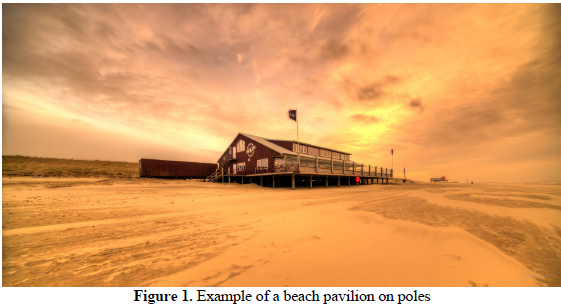The coast is a very attractive place where people like to spend time. Therefore, various beach pavilions area located at the beach; close to the sea, and just in front of the dunes. At the same time coastal dunes form the first line of defense for high water and large waves during severe storm events. During these storm events the dunes erode, and after the storm the dunes gradually rebuild due to wind-driven sediment transport.
From a coastal safety perspective, the wind-driven sediment transport that naturally rebuilds the coastal defenses should not be obstructed. Tourism on the other hand would like to have pavilions present at the beach. These two seemingly contradicting views are calling for an optimization: Still allow buildings at the beach, while minimizing the obstructing effect of pavilions on the regrowth of the coastal dunes after storm events.
Beach houses are frequently placed on poles (see e.g. Figure 1), allowing wind-driven sediment transport from the beach to pass underneath the building. However, depending on set-up and conditions the air flow can also lead to unwanted local sand deposition (Figure 2). Previous research (Pourteimouri, 2023; Zuiderwijk 2023) performed systematic numerical experiments to study highly schematized beach houses and their effects on aeolian sediment transport.

This MSc project will focus on more realistic beach pavilion configurations, often close to beach access points in the coastal dune row, affecting sediment transport towards dunes. You will perform a model study on the airflow around beach pavilion, and investigate related sediment transport patterns towards the dunes. A model that can solve the airflow around buildings and over a dune topography has been developed in our group in the opensource CFD solver OpenFOAM (Pourteimouri, 2023). The obtained airflow patterns will be used together with a sediment transport equation to obtain the beach dune dynamics due to the presence of the beach pavilion.
Are you more familiar with water flow, but you like numerical modelling? Don’t worry! As long as wind does not exceed roughly 100 m/s, air can just like water be modelled as incompressible flow using the exact same model formulations that you are used to.
This project gives you an opportunity to learn more about CFD and OpenFOAM, which is widely used open source numerical modelling software for Computational Fluid Dynamics, not only for airflow. Furthermore, you will get to know what it is like to do research in the Marine and Fluvial Systems group in WEM and/or to get insight in how it is to work at W+B.
We are looking for an enthusiastic student who is interested in numerical modelling.
References
- Zuiderwijk, N.L., Modelling the impact of positioning and pole height of a row of beach buildings on dune morphology, MSc thesis, WEM, University of Twente, 2023,
- Pourteimouri, P., The influence of characteristics, orientation and positioning of beach buildings on airflow and aeolian sediment transport patterns in the surrounding area, PhD thesis, WEM, University of Twente, 2023.





